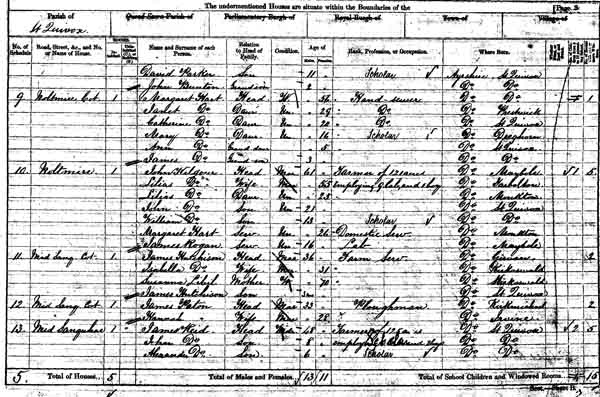1861 Census
1861 Census
The 1861 Census was taken on Sunday 7 April under the provisions of the Census of Scotland Act 1860. It was the first census following the introduction of statutory civil registration in 1855 and the Registrar General for Scotland was given responsibility for its administration.
The population of Scotland on 8 April 1861 was 3,062,294.
This guide covers:
1861 Census Questions
In 1861 there were two new questions about:
- the number of children aged between five and 15 attending school or being educated at home
- the number of rooms with one or more windows (reflecting concerns about housing and sanitary conditions and not to be confused with the window tax which had been abolished in 1851).
This example is from the 1861 Census for St Quivox in Ayrshire (our reference 1861/612/1, page 3). The number of rooms with one or more windows is five for the two farmers but only one or two for the ploughman, farm servant and weaver. In large houses the figure would be 10 or more while at Skelmorlie Castle in the parish of Largs it is 29.
1861 Census Enumerators’ Instructions
Local registrars divided their districts into enumeration divisions of approximately 200 houses. Institutions such as hospitals, prisons and hotels with over 50 inhabitants were enumerated separately. In other respects arrangements followed those of the 1851 Census. You can find further information about the running of the census and the abbreviations used for occupations and relationship to the head of household in this pdf copy of a typed transcription of the ‘General instructions to the enumerator’.
1861 Census Street Indexes
Census street indexes provide registration district (RD) and enumeration district (ED) references for each street in a city or urban area. They also cover institutions such as asylums, hospitals, workhouses, prisons, police stations and barracks as well as hotels and public buildings.
There are 16 street indexes for the 1861 census. They have been digitised and are made available as pdf files that are several megabytes in size.
If you can’t find a particular street it may not have existed in 1861 or may have had a different name.
